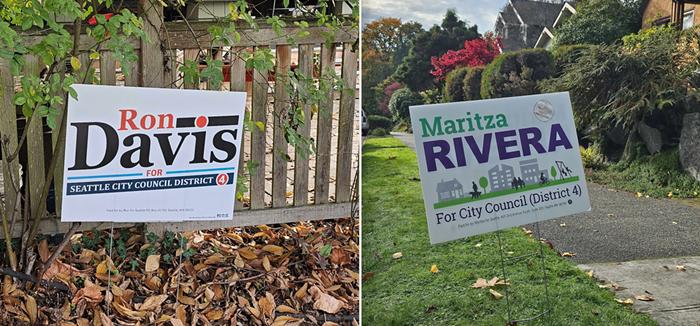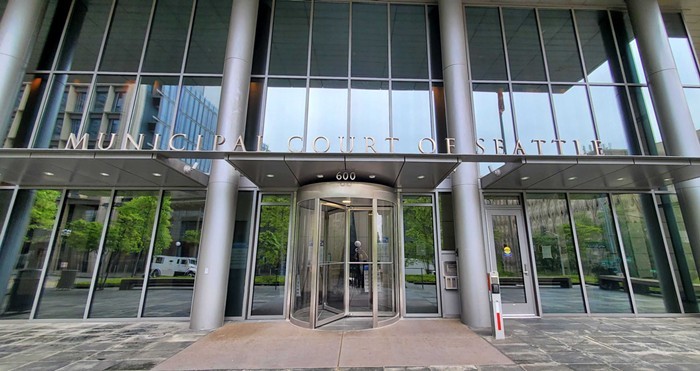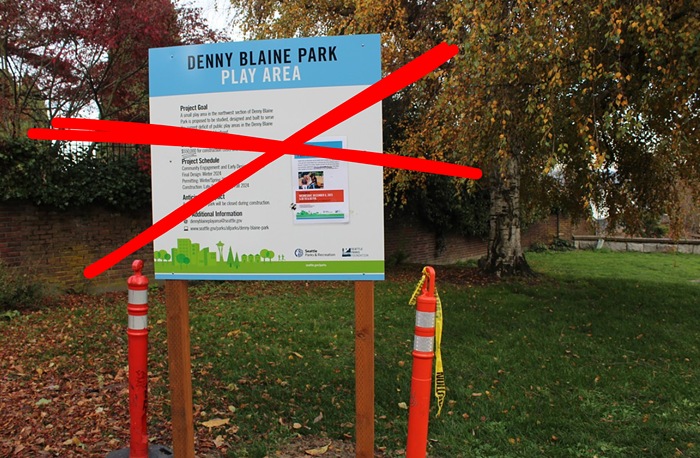We're crammed into the back of a crowded white tour bus—four members of the Seattle City Council, one council staffer, two San Francisco transportation planners, and me—bumping our way along the busy Embarcadero, a wide expanse of pavement that hugs San Francisco's eastern waterfront. We've spent much of the morning in the company of a half-dozen city and Port of San Francisco officials, learning about the fractious history of San Francisco's waterfront, and we've missed our 11:30 tour time by a generous hour and a half.
Consequently, we're hurtling past most of the Embarcadero's best-known success stories: The Ferry Building, which was transformed by a $100 million renovation into a gleaming historic structure fronted by a bustling public plaza; SBC Stadium, home of the Giants, which faces a gorgeous view of the San Francisco Bay; and a succession of renovated and revitalized piers, many of which were crumbling relics before a multiyear, multimillion-dollar reclamation effort began with the demolition of the elevated Embarcadero Freeway in 1991. As we head south, our tour guide, Port of San Francisco Waterfront Planner Dan Hodapp, points out some of the lesser-known highlights along our route: South Beach, where tall glass-walled condos bump up against pocket parks; the UC San Francisco biomedical campus, a maze of institutional green and orange boxes; and the still-nascent office park at Mission Bay to the south, where pale-green office buildings with "for lease" signs dot a landscape of debris-strewn construction sites and parking lots.
The council's trip to San Francisco is fortuitous, and not just because the sun is shining. Seattle council members are on the brink of several major decisions, among them what kind of redevelopment is best for Seattle's central waterfront; how much of the "authentic" (i.e., industrial) waterfront should be preserved; and what sort of urban planning should take place in the area (parks, active open spaces, and commercial developments are among many conflicting possibilities). And all of those decisions rest, ultimately, on what the city decides to do about the crumbling Alaskan Way Viaduct, which was damaged in the 2001 Nisqually Earthquake and must be torn down or replaced.
In 1989, San Francisco faced a similar dilemma: The two-level elevated Embarcadero Freeway, which citizens voted to preserve in 1986, was badly damaged in the Loma Prieta earthquake, leading city leaders to close it down and forcing car traffic to find another way through the city. In the earthquake's immediate aftermath, officials predicted gridlock for miles in each direction; but that gridlock never materialized, and eventually, Mayor Art Agnos—seconded by a closely divided San Francisco Board of Supervisors—decided to tear it down, reducing car capacity on the waterfront and distributing Embarcadero traffic onto city streets.
Despite the nightmare scenarios painted by those who opposed its demolition, the Embarcadero today is a relatively uncrowded, six-lane surface thoroughfare: it carries 16,000 vehicles a day (compared to a previous level of up to 110,000), with the remaining trips either eliminated or distributed onto city streets.
Along the waterfront, you can see the tangible benefits of redevelopment: Besides the new and renovated structures, landscaping and transit improvements have made the area a local and tourist destination. A motley assortment of vintage trolley cars tools down separate trolley lanes in a rock-lined median; palm trees help shade the expansive sand-colored sidewalks; and dozens of people ice skate in a nearby park as the sun sets on Friday night. During the day, the sidewalks are jammed with pedestrians, Rollerbladers, and bikers.
To some, such as council member Peter Steinbrueck, the Embarcadero serves as a promising model for what a post-viaduct Alaskan Way could be: a pedestrian-friendly surface road with plenty of room for transit, bikes, and cars. Plenty of people, including Steinbrueck, are starting to suspect that the waterfront cut-and-cover tunnel advocated by Mayor Greg Nickels, estimated at around $4 billion but likely to cost much more, is an unrealistic boondoggle that should be replaced with a more sensible alternative. The most promising such alternative—a surface roadway that would reduce the viaduct's capacity but would include improvements to transit and the transportation grid downtown, enabling traffic to move elsewhere and giving commuters alternatives to get where they want to go—is gaining momentum as hope for another $2 billion to pay for the unfunded portion of the viaduct grows dimmer.
The no-rebuild alternative, supported by groups like the People's Waterfront Coalition, includes proposals that would increase transit use, decrease demand for car travel, and divert traffic onto city streets that parallel the viaduct, some of which use less than 60 percent of their full capacity. The PWC suggests that relatively minor improvements—such as improved signal timing, transit investment, and lane reconfigurations on I-5—could absorb much of the viaduct's traffic at a far lower cost than digging a tunnel. And even the city's own studies predict that changes such as traffic demand management—encouraging people to choose options other than driving alone—could reduce viaduct traffic by a third.
WSDOT, which has consistently supported the tunnel option, predictably claims that, without the viaduct, "heavy traffic congestion would be experienced" from early morning until late evening from Pioneer Square to Belltown and beyond. In San Francisco, freeway proponents made similar predictions. But the truth is, no city that has torn down a freeway has ever experienced that kind of gridlock. In 1998, a British study revealed that 60 cities that reduced highway capacity saw an average decrease in auto traffic of 20 percent, with some cities seeing reductions as high as 60 percent. Even here in Seattle, when the Nisqually earthquake forced temporary closure of the viaduct, traffic in that corridor—previously 110,000 vehicles a day, about the same level as the pre-demolition Embarcadero—went down by 30,000 trips. Faced with the prospect of sitting in nightmarish traffic, people simply find other ways to get around.
The Embarcadero and the viaduct aren't exactly comparable, as tunnel proponents are fond of pointing out. Part of a planned waterfront freeway system that was never completed, the Embarcadero's main function, according to San Francisco consultant Boris Dramov—who gave council members a detailed history of the waterfront on Friday morning—was "storing cars" queued up to get on the Bay Bridge. The viaduct, in contrast, carries between 20 percent and 25 percent of the north-south traffic through Seattle. And San Francisco's transit system is decades ahead of Seattle's: About 80 percent of downtown commuters travel on the city's complex web of interlocking transit systems, which include commuter rail, light rail, streetcars, and buses.
San Francisco's success tearing down elevated freeways, however, is not limited to the Embarcadero. The double-decker Central Freeway, which for decades cut through San Francisco's Hayes Valley neighborhood and served as a haven for drug dealers and prostitutes, once carried about 90,000 cars a day. Today, that traffic is distributed through the area, with a new boulevard designed to enhance the area and provide a "linear park" for the revitalized neighborhood.
The complaints made by highway proponents in San Francisco in the early 1990s are remarkably similar to those being made by highway proponents in Seattle today. Business interests in nearby Chinatown said the freeway was essential to their neighborhood; advocates for industry held out hope that San Francisco's declining maritime businesses would one day recover; downtown workers didn't want to lose parking under the freeway; and highway commuters complained that they would lose their stunning views of the bay. Initially, San Francisco planners preferred to replace the Embarcadero with an underground tunnel, which city of San Francisco transportation planner Rebecca Kohlstrand says people now recognize would have been a "huge mistake," because it would have required a 200-foot-long cut right in front of the landmark Ferry Building. Here in Seattle, the proposed viaduct tunnel would require a similar structure: Current plans call for the tunnel to end directly in front of Pike Place Market, ejecting thousands of cars onto an elevated roadway just in front of Victor Steinbrueck Park.
City Council members say San Francisco's experience was instructive, though not always in the ways San Francisco city planners might have hoped. Outgoing council president Jan Drago, who takes over next year as chair of the transportation committee, said the six-lane Embarcadero was "too wide" for Seattle, and lamented the lack of street trees and open green space—homages San Francisco planners made to their waterfront's stark industrial heritage. Other challenges in San Francisco have included a community movement that delayed waterfront development for six years and prohibited all hotels on the waterfront; state laws that restrict the kind of uses allowed in the historic piers; and San Francisco's newly approved district election system, which places most port property in the district of a single city supervisor, and outside the jurisdiction of the remaining 10.
Although some, like Drago, say they still have "very little interest" in the PWC's no-highway proposal, others, such as Steinbrueck, seem increasingly open to the idea of an Embarcadero-style viaduct redevelopment in Seattle. According to Steinbrueck, San Francisco city planners "have found ways to redirect traffic, reduce traffic, and get people using public transit—all of which we need to be doing here aggressively." Cary Moon, the PWC cofounder who has encouraged council members to question WSDOT's pro-highway predisposition, says she's heartened by the council members' willingness to look at the Embarcadero as a potential model for Seattle. "Just the fact that they're open to the possibility that you can reduce highway capacity is hugely encouraging."
barnett@thestranger.com

















